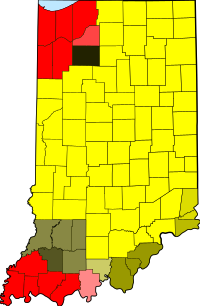Week 10: Hoosier Time
As we begin Daylight Savings, we’ve got to ask, “Hey Indiana, what time is it?”
In 1916, facing energy shortages during World War 1, Germany decided to set their clocks forward in the spring and back in the fall, to get more sunlight into the work day. The rest of Europe soon followed suit. The United States dawdled until 1918, when it passed the Standard Time Act, which enacted Daylight Saving Time (DST) and also cleaned up lots of jagged time zone lines. At that time, the entire state of Indiana was placed in the Central Time Zone. (Simple.)
Rationality lasted exactly one year. In 1919 the U.S. repealed DST as a federal mandate but allowed any county to continue to observe it. Some Indiana counties did so and some did not, resulting in a complete zonal mess and logistical nightmares that lasted for decades, with a short break of sanity when DST was mandated again during World War 2. (War is always good for organization.)
In 1961, the state legislature decided to run the time zone line right down the middle of the state, but allowed counties to continue to observe DST voluntarily. But then the U.S. government passed the Uniform Time Act in 1966 which gave the Department of Transportation the authority to sort it all out. The governor of Indiana begged for the whole state to be placed back into the Central Time Zone. The county legislatures screamed. Broadcast companies threatened to sue the federal government if their footprints were cut in two.(Everybody crossed their fingers.)
In 1967, in a decision worthy of Solomon, six counties in the northwest (suburbs of Chicago) and six counties in the southwest (suburbs of Evansville) were placed in the Central zone so commuters’ residences would be on the same time as their offices, while the rest of the 82 counties were placed in the Eastern Zone. But, observance of DST was still voluntary, and only the easternmost counties near Louisville and Cincinnati did so, which meant that lots of central Indiana was acting like an Eastern state in the winter but like a Central state in the summer. (Got that?)
It was a hodge-podge for forty years. Finally in 2006, Indiana became the 48th state to enforce DST statewide, which of course caused a few counties to shift from one zone to the other. At last, everybody was happy. (Except for Martin County, in the Central Zone, whose largest employer is a military base whose workers mostly reside in two Eastern counties next-door, and who were literally changing time zones when they crossed the street to work, so Martin County reverted back to the Eastern Zone…)
The argument rages on. Commercial folks argue that Indiana should be completely in the Eastern Zone and follow DST, so it’s easier to do business with the state. Detractors claim that being in the Eastern Zone with DST results in higher energy usage from running air conditioners later in the day. And educators point out that Eastern Zone Indiana is so dark in the morning that de-icers don’t work, vehicle collisions have increased, school delays are more common, and Indiana’s teen suicide rate is way above the national average. (Yikes.)
And the whole situation might be soon overruled at the Federal level. The Sunshine Protection Act of 2021, which would make DST permanent on November 5, 2023, has passed the Senate and awaits a vote by the house. But then again, President Biden could veto it, as he is so divisive and cognitively impaired. (Or so they tell us.)
And at the heart of the whole controversy is the small but significant point that Daylight Saving Time has had a problem from the very beginning. It’s not a science thing or a pattern thing or a culture thing. It’s a spelling thing! The fact is, it’s technically not ‘Daylight SavingS’ with an S, officially it’s always been just ‘Daylight Saving.’ We’ve all been saying it wrong. A tiny point to be sure, but it means that the word is actually a verb, not a noun. Which means we’ve been doing it all along, but kind of wrong. Which means it’s had bad karma from the beginning. And so, yeah, we really should just get rid of it. And in the ultimate irony, the way to get rid of it is to make it permanent and stop saying it. (Oy.)
In the meantime, chaos reigns in Indiana.
See you Monday morning, Hoosiers. Have an extra cup of coffee and drive carefully.
